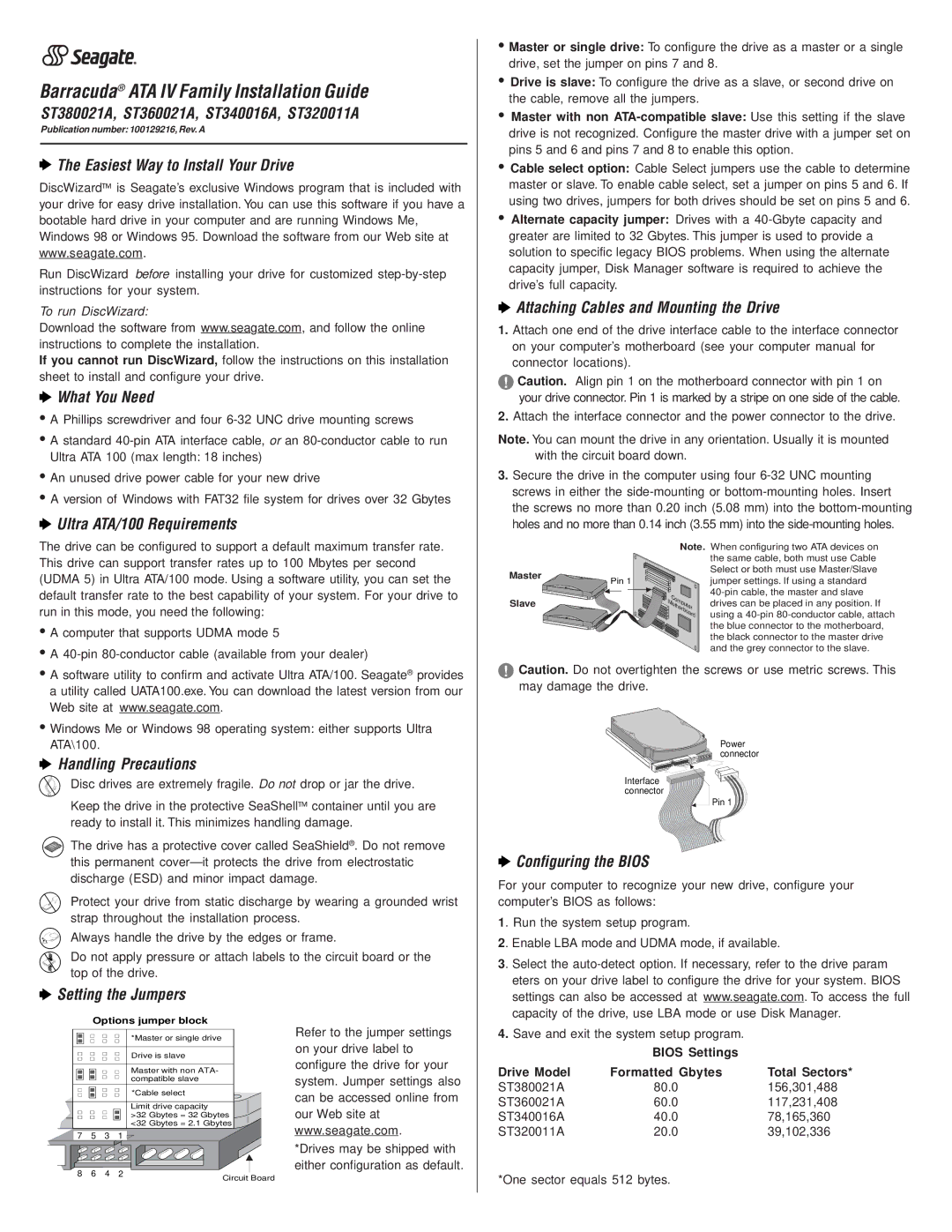Barracuda® ATA IV Family Installation Guide
ST380021A, ST360021A, ST340016A, ST320011A
Publication number: 100129216, Rev. A
 The Easiest Way to Install Your Drive
The Easiest Way to Install Your Drive
DiscWizard is Seagate’s exclusive Windows program that is included with your drive for easy drive installation. You can use this software if you have a bootable hard drive in your computer and are running Windows Me, Windows 98 or Windows 95. Download the software from our Web site at www.seagate.com.
Run DiscWizard before installing your drive for customized step-by-step instructions for your system.
To run DiscWizard:
Download the software from www.seagate.com, and follow the online instructions to complete the installation.
If you cannot run DiscWizard, follow the instructions on this installation sheet to install and configure your drive.
 What You Need
What You Need
•A Phillips screwdriver and four 6-32 UNC drive mounting screws
•A standard 40-pin ATA interface cable, or an 80-conductor cable to run Ultra ATA 100 (max length: 18 inches)
•An unused drive power cable for your new drive
•A version of Windows with FAT32 file system for drives over 32 Gbytes
 Ultra ATA/100 Requirements
Ultra ATA/100 Requirements
The drive can be configured to support a default maximum transfer rate. This drive can support transfer rates up to 100 Mbytes per second (UDMA 5) in Ultra ATA/100 mode. Using a software utility, you can set the default transfer rate to the best capability of your system. For your drive to run in this mode, you need the following:
•A computer that supports UDMA mode 5
•A 40-pin 80-conductor cable (available from your dealer)
•A software utility to confirm and activate Ultra ATA/100. Seagate® provides a utility called UATA100.exe. You can download the latest version from our Web site at www.seagate.com.
•Windows Me or Windows 98 operating system: either supports Ultra ATA\100.
 Handling Precautions
Handling Precautions
Disc drives are extremely fragile. Do not drop or jar the drive.
Keep the drive in the protective SeaShell container until you are ready to install it. This minimizes handling damage.
The drive has a protective cover called SeaShield® . Do not remove this permanent cover—it protects the drive from electrostatic discharge (ESD) and minor impact damage.
Protect your drive from static discharge by wearing a grounded wrist strap throughout the installation process.
Always handle the drive by the edges or frame.
Do not apply pressure or attach labels to the circuit board or the top of the drive.
•Master or single drive: To configure the drive as a master or a single drive, set the jumper on pins 7 and 8.
•Drive is slave: To configure the drive as a slave, or second drive on the cable, remove all the jumpers.
•Master with non ATA-compatible slave: Use this setting if the slave drive is not recognized. Configure the master drive with a jumper set on pins 5 and 6 and pins 7 and 8 to enable this option.
•Cable select option: Cable Select jumpers use the cable to determine master or slave. To enable cable select, set a jumper on pins 5 and 6. If using two drives, jumpers for both drives should be set on pins 5 and 6.
•Alternate capacity jumper: Drives with a 40-Gbyte capacity and greater are limited to 32 Gbytes. This jumper is used to provide a solution to specific legacy BIOS problems. When using the alternate capacity jumper, Disk Manager software is required to achieve the drive’s full capacity.
 Attaching Cables and Mounting the Drive
Attaching Cables and Mounting the Drive
1.Attach one end of the drive interface cable to the interface connector on your computer’s motherboard (see your computer manual for connector locations).
!Caution. Align pin 1 on the motherboard connector with pin 1 on your drive connector. Pin 1 is marked by a stripe on one side of the cable.
2.Attach the interface connector and the power connector to the drive.
Note. You can mount the drive in any orientation. Usually it is mounted with the circuit board down.
3.Secure the drive in the computer using four 6-32 UNC mounting screws in either the side-mounting or bottom-mounting holes. Insert the screws no more than 0.20 inch (5.08 mm) into the bottom-mounting holes and no more than 0.14 inch (3.55 mm) into the side-mounting holes.
| | Note. When configuring two ATA devices on |
| | | the same cable, both must use Cable |
| Master | | Select or both must use Master/Slave |
| Pin 1 | jumper settings. If using a standard |
| |
| | Computer | 40-pin cable, the master and slave |
| Slave | drives can be placed in any position. If |
| | Motherboard | using a 40-pin 80-conductor cable, attach |
| | | the blue connector to the motherboard, |
| | | the black connector to the master drive |
| | | and the grey connector to the slave. |
!Caution. Do not overtighten the screws or use metric screws. This may damage the drive.
Power connector
Interface 
 connector
connector 

Pin 1
 Configuring the BIOS
Configuring the BIOS
For your computer to recognize your new drive, configure your computer’s BIOS as follows:
1. Run the system setup program.
2. Enable LBA mode and UDMA mode, if available.
3. Select the auto-detect option. If necessary, refer to the drive param eters on your drive label to configure the drive for your system. BIOS

